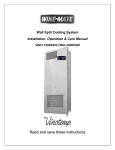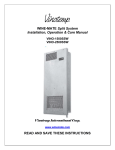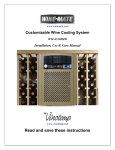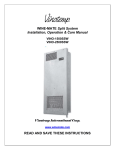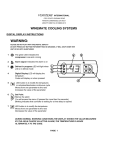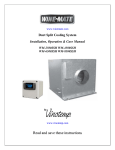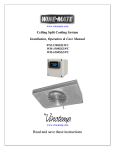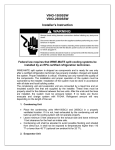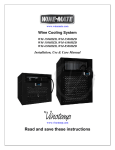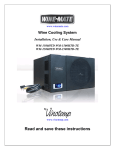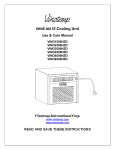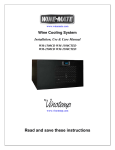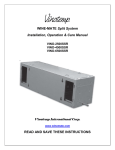Download Vinotemp WINE-MATE WM-150SCU Specifications
Transcript
www.winemate.com Split Cooling System Installation, Operation & Care Manual WM-1500SS WM-1900SS www.vinotemp.com Read and save these instructions Important Safety Information WARNING: • Do not use a ground fault interrupter (GFI). • A dedicated 20 AMP circuit is required. -1- Table of Contents Cellar Construction.…………………………….……………..3 Features & Specifications…………………….….…………..4 Temperature Control…...……….…………..………..……….5 Care Guide………………………………………………………6 User’ Troubleshooting…….……………………………….....7 Installer’s Instructions………….…..….……..…………….10 Electrical Wirings..…………….…..….……..………………18 Customer Support……………………………………………20 Warranty……………………………………………………….21 -2- Cellar Construction This is only a guide and shall be considered as minimum requirements. All interior walls and floors shall have a vapor barrier and a minimum of R13 insulation. All exterior walls and ceiling shall have a vapor barrier and a minimum of R19 insulation. The vapor barrier shall be installed on the warm side of the insulation. All joints, door frames, electrical outlets or switches and any pipes or vents that go through the cellar shall be sealed to prevent air and moisture leakage into the cellar. Concrete, rock, and brick are not insulation or vapor barriers. Doors shall be of a minimum size, insulated to at least R13 and tightly sealed with high quality weather stripping. Be sure to seal the bottom of the door and fill gap between the door’s frame and wall before installing the cap molding. In order to maintain 55 °F in the wine cellar, the ambient temperature surrounding the enclosure shall not exceed the temperature of the cellar by more than 25 °F. No cellar wall shall receive direct sun or strong wind. Lighting shall be of low wattage, with a timer to insure lights are not left on when the cellar is not occupied. The cooling system will not be able to maintain the proper temperature if fresh moisture-laden air is constantly being introduced to the cellar. Symptoms of this condition are; cooling unit runs all the time with only a slight reduction in temperature and/or water overflows from the unit. Because of the temperature difference between the inside and outside, very small cracks can allow large amounts of outside air to enter into the cellar. Please be aware that moisture can pass through solid concrete, paint and wood. Often a newly constructed cellar contains fresh wood, paint, concrete and other building materials. These materials contain large amounts of moisture. When placed into operation in this type of environment, the system will work harder to remove this extra moisture resulting in increased “run” time. -3- Features and Specifications • • • • • • Wine-Mate split cooling systems WM-1500SS and WM-19000SS are designed and used to provide a cold temperature between 50~65 °F for a properly insulated wine cellar. The wine cellar will maintain humidity range within 50~70% RH. These temperature and humidity ranges like in natural caves are optimized for long term storage of wine. SS unit consists of a condensing unit and an evaporator unit; they are connected by a liquid line and an insulated suction line. SS condensing unit can be located away from the wine cellar 50 ft so that noise and compressor vibration are isolated. WM-1500SS evaporator unit can be installed on the ceiling and WM-1900SS evaporator unit can be installed on the wall inside a wine cellar. NOTE: Capacity is determined under the cellar, the cellar ambient and the condensing unit ambient temperatures of 55°F, 75°F and 90°F, with R13 interior and R19 exterior insulations. Any higher ambient temperatures, lower insulations will cause reducing capacity and the cellar temperature may not be maintained at 55°F. CAUTION: If the installation area will be below 50°F, purchase a low ambient condition kit. NOTE: To prepare rough-in, leave minimum 4” clearances for electrical wiring and refrigeration piping. The specifications and dimensions are listed as follows: Model No WM1500SS WM1900SS Evap Unit L”xD”xH” Cond Unit L”xD”xH” Btu/h CFM Cellar Size (cu ft) Refrigerant Electrical Evap Unit/ Cond Unit Weight (lb) Evap Unit/ Cond Unit WM-15SFC WM-150SCU 16.75x14.5x4.75 WM-19SFC 17.75x4.5x13.125 18x14x12 WM-150SCU 18x14x12 1500 180 150 R134a 115V-60HZ-1.0A 115V-60HZ-3.1A 15/30 1500 180 150 R134a 115V-60HZ-2.2A 115V-60HZ-3.1A 20/30 Also see Fig. 1, 2 & 3 for further info. -4- Temperature Control 1. Temperature Setting • • • Set the temperature at 55 °F for the optimum aging of wine On initial start-up, the time required to reach the desired temperature will vary, depending on the quantity of bottles, temperature setting and surrounding temperature. Allow 24 hours to stabilize the temperature for each new temperature setting operation 2. Use of the thermostat • • Turn clockwise to decrease temperature. Turn counter clockwise to increase temperature. -5- Care Guide In general, always unplug system or disconnect power while doing care. 1. Coil Cleaning • • Clean the condenser coil regularly. Coil may need to be cleaned at least every 6 months. Use a vacuum cleaner with an extended attachment to clean the coil when it is dusty or dirty. 2. Condensate Removing • Remove the excessive condensate if it is accumulated in the wine cellar at high humidity conditions. -6- User’s Troubleshooting This Troubleshooting Chart is not prepared to replace the training required for a professional refrigeration service person, not is it comprehensive. Complaint 1. Unit not running 2. Unit not starting , but temperature rising high 3. Temperature fluctuating 4. Temperature high, unit stopping and starting normally 5. Temperature high, unit stopping and starting with short running time 6. Temperature Possible Causes a. b. c. d. e. f. g. h. i. a. Power cord not plugged No power from supply Incorrect or loose wirings Low voltage Setting higher than ambient temperature Waiting for cut-in Defrost light blinking Compressor light blinking Defective controller Anti-short cycle a. Air probe a. Temperature setting high Response a. b. c. d. e. Check power cord Check receptacle and fuses Check all wirings and connections Contact an authorized electrician Lower temperature setting f. g. h. i. a. Wait Unit is under defrost mode Unit is under anti-short cycle delay Call service for diagnosis Reset AC a. When using an air probe, the wine bottle temperature is mainly controlled by the average air temperature. If the set-point is 55°F with the differential 4F, the cooling unit turns on at 59°F of air temperature (It may be higher than 59°F if it is in anti-short cycle or defrost cycle) and turns off at 55°F of air temperature. The average air temperature is 57°F, and then the wine temperature is around 57+/0.5°F. The air is light enough to change so quickly that it maintains relatively constant average temperature that would prevent wine bottle temperature from fluctuating. a. Lower the setting a. Air probe touching the evaporator coil, displaying temperature ok b. Air probe in cold-air supply, displaying temperature ok c. Failed controller and probe a. Move the air probe away from the evaporator a. Improper cellar insulation & seal a. Check insulation, gasket and door opening -7- b. Move the air probe away from the cold-air supply c. Call service for diagnosis high or not cooling and running continually b. Cellar too large c. Ambient temperature too high d. Exhaust restricted e. Malfunctioning fans 7. Unit running too long f. Evaporator or condenser airflow g. h. i. j. k. l. Dirty Condenser Iced evaporator Refrigeration system restriction Refrigerant leak Undercharge or overcharge Failed components a. Improper cellar insulation & seal b. Exhaust restricted c. d. e. f. 8. Condenser fan running but compressor not running 9. Compressor running but condenser fan not running 10.Temperature high, compressor stopping and starting but very short running time 11.Evaporator fan running too long 12. Evaporator Cellar too large Ambient temperature > 90°F Dirty Condenser Improper condenser air flow a. Incorrect or loose wirings b. Failed components c. Liquid refrigerant compressor in a. b. c. d. Fan blade stuck Incorrect or loose wirings Failed motors Fan cycle control the a. Failed components b. c. d. e. Improper condenser airflow Dirty condenser Overcharge of refrigerant Discharge or suction pressure too high a. Post-compressor fan running mode for humidity modulation a. Incorrect or loose wirings -8- b. Check for excessive size c. Check installation location d. Leave minimum 3 feet clearance for the hot air exhaust side and leave minimum 1 foot clearance for the ambient air intake side e. Check for both evaporator and condenser fans f. Check for air restrictions, air shortcirculation, grille directions g. Clean condenser h. Defrost and reset temperature i. Call service j. Call service k. Call service l. Check compressor windings, start relay and overload protector a. Check insulation, gasket and door opening b. Leave minimum 3 feet clearance for the hot air exhaust side and leave minimum 1 foot clearance for the ambient air intake side c. Check for excessive size d. Check for installation location e. Clean condenser f. Check for fan and air short circulation a. Check all wirings and connections b. Check start relay, start capacitor, overload protector, compressor. c. Call service. a. b. c. d. Check for proper clearance Check all wirings Call service Check for setting a. Check compressor windings, start relay and overload protector. b. Check for condenser fan c. Clean condenser d. Call service for removing refrigerant e. Call service for information a. Reset FON a. Check all wirings and connections fan running but condensing unit not running 13.Evaporator freezing up b. Failed components c. b. Check start relay, start capacitor, overload protector, compressor. c. Call service Low refrigerant a. Check for fans and CFM b. Check for fans and CFM c. Check for seal, door opening, ambient temperature and temperature setting d. Check for controller and probe e. Change defrost cycle f. Call service 15.Excessive condensate in wine cellar a. Evaporator air flow restriction b. Condenser air flow restriction c. Not stopping due to air leak, high ambient temperature or low temperature setting d. Defective controller or probe e. Low ambient temperature f. Initially working then stopping, moisture in the system g. Refrigerant low or leaking h. Expansion valve blockage a. Air leak in the wine cellar causing excessive condensate b. High humidity causing excessive condensate c. Evaporator air flow restriction d. Drain restricted or unit not level, and water overflowing e. Drip tray leak (No overflow but leak) a. Air leak in the wine cellar causing excessive condensate b. High humidity causing excessive condensate c. Drain restricted 16.Condensate inside ducts a. Drain line restricted b. Continually running not stopping a. Check for drain b. raise temperature setting or increase defrost cycle c. Increase air flow or raise temperature setting a. Check for insulation b. Use dehumidifier c. Increase air flow or raise temperature setting a. Check for proper fuse or breaker b. Check for wirings and connections c. Call service a. Add support to improve installation b. Check fan blades, bearings, washers, tubing contact and loose screws. c. Check for airflow 14.Water leak c. Too cold supply air 17.Condensate outside ducts a. Duct not insulated b. High humidity c. Too cold supply air 18.Circuit tripping a. b. c. a. b. 19.Noisy operation Incorrect fuse or breaker Incorrect wirings Failed components Mounting area not firm Loose parts c. Compressor overloaded due to high ambient temperatures or airflow restriction d. Defective components -9- g. Call service h. Call service a. Check for air leak b. Use drain line c. Check supply air flow or air TD d. Clean the drip tray and drain line e. Seal the leak using silicone sealant a. Check for any air leak b. Use drain line c. Clean the drip tray and drain line d. Call service for checking internal loose, inadequate lubrication and incorrect wirings Installer’s Instructions Federal law requires that WINE-MATE split cooling systems be installed by an EPA certified refrigeration technician. 1. General Instructions WINE-MATE split system is shipped as components and is ready for use only after a certified refrigeration technician has properly installed the system. Proper installation is critical. Vinotemp can only warrant the quality of the components. The installation and proper operation of the system must be warranted by the installer. Installation of the system must be done in accordance with all state and local building and electrical codes. The condensing unit and evaporator unit are connected by a liquid line and an insulated suction line that are supplied by the installer. These lines must be properly sized for the distance between the two units. After the units and lines are connected, the system must be checked for restriction, pressurization and leak. Then the system must be evacuate and charged with refrigerant. Refrigerant amount will vary depending on the length of line set. Parts included: Evaporator Unit (liquid line solenoid valve and expansion valve, thermostat installed) Condensing Unit (discharge and suction valves installed) Liquid Filter Liquid Indicator Parts not included: Liquid line copper tubing Suction line copper tubing - 10 - CAUTION: Liquid and suction line locations may differ from what are shown here, please check on the units for proper installation. Fig. 1 WM15SFC Evaporator Unit Fig. 2 WM-19SFC Evaporator Unit - 11 - Fig. 3 WM-150SCU Condensing Unit Fig. 4 Liquid Filter Fig.5 Liquid Indicator 2. Evaporator Unit Installation 1) The WM-15SFC evaporator units shall be installed for ceiling mount with the air supply towards horizontally and air return on the bottom. 2) The WM-19SFC evaporator unit shall be installed for wall mount with the air supply towards top and air return on the sides. 3) Air supply shall be unobstructed minimum 12” for a direct blow installation; air return shall be unobstructed minimum 6”. 4) A grille can be used to cover the supply and return with 0~2” clearance; or 2-3 ft long duct can be added. 5) There is a gravity drain system used, so the unit shall be installed level or with a slight slope downward the drain connection and the drain line shall be installed slope down toward the drain. If rise-up is needed, a condensation pump must be used. - 12 - 3. Condensing Unit Installation CAUTION: Low ambient condition kit is required if the installation area will be below 50°F. If the condensing unit is equipped with a low ambient condition kit, do not turn on the compressor until the condensing unit has been powered for minimum 12 hours. 1) Place the condensing unit WM-150SCU in a properly ventilated location. If it is not, heat exhausted by the condensing unit will build up and the cooling system will not operate properly. 2) Condensing unit shall be elevated to avoid possible flooding and shaded from direct sun. It shall not be exposed to temperatures higher than 110 °F or lower than 50 °F. 3) Leave minimum 5 ft clearance for the exhaust side and leave minimum 1 foot clearance for the ambient air intake side. 4) Service valve operations 1 - Process or Manometer 2 – Receiver Discharge or Compressor Suction 3 – Liquid Line or Suction Line 4 - Pressure Control Back Position: Normal operation, process and manometer port closed Front Position: Liquid/suction line connection closed Middle Position: All ports open for evacuation, charge and manometer BACK POSITION FRONT POSITION Fig. 6 ROTALOCK Valve Operation - 13 - MIDDLE POSITION BACK POSITION FRONT POSITION MIDDLE POSITION Fig. 7 Base Valve Operation 4. Checking Pressure Control Settings 1) Use of the encapsulated pressure control (if applicable, sold separately) Fixed suction pressure setting: Cut in = 32 psig; Cut out = 10 psig Fig. 8 Fixed Pressure Control 2) Low ambient condition kit (if applicable) A. Use of the crankcase heater The crankcase heater is installed around the lower part of the compressor and shall be turned on all the time. The heater is self-regulated. B. Use of the condenser fan control Head pressure setting: Cut in=170 psig; Cut out=110 psig; Differential=60 psig It closes on rise of pressure. It may need to adjust the setting in the field to avoid fan short cycle. - 14 - Fig. 9 Condenser Fan Cycle Control 5. Refrigeration Piping and Leak Testing NOTES: • The line connection sizes of liquid filter & indicator, the valve connection sizes of condensing unit and the line connection sizes of evaporator unit are not necessary the same as the listed refrigeration line sizes. • If the condensing unit is installed above the evaporator unit, use the suction line one listed size smaller. • Expansion and solenoid valves have been installed on the liquid line in the evaporator unit. 1) The installation order starts from condensing unit (including receiver and discharge valve), liquid line filter-drier, moisture-liquid indicator, liquid line, to evaporator unit (including liquid line connection, solenoid valve, expansion valve, and suction line connection), returning to insulated suction line, suction valve and then back to condensing unit. 2) If the condensing unit is located below the evaporator unit, use inverted U trap to prevent liquid from flooding back to the compressor; if the elevation difference is more than 10 ft or the line set exceeds 75 ft, use both inverted U trap and suction accumulator. 3) If the condensing unit is located more than 10 ft above the evaporator unit, use U trap to aid oil returning to the compressor. 4) Complete pipe brazing, check solenoid valve and expansion valve restrictions and test leak. 5) Hook up the drain line and check if water drains. The line sizes and refrigerant charges are listed as follows. Model No Equivalent Line Set Liquid Line Suction Line - 15 - Drain Line Recommended Charge WM-1500SS WM-1900SS <= 75 FT <= 75 FT 1/4" OD 1/4" OD 3/8” OD 3/8” OD 1/2” OD 1/2” OD R134a/15 OZ R134a/15 OZ 6. Connecting Electrical Wires Connect all electrical components using the wiring diagrams in accordance with all state and local codes. 7. Evacuating, Charging and Starting the system CAUTION: • Always use the superheat and subcooling, pressure readings to charge refrigerant properly; the listed charge amounts are used for reference only. • If the unit is equipped with a low ambient condition kit and installed in the summer, charge 15% more refrigerant. • If the low ambient condition kit is used, turn off the compressor before power the condensing unit. Only turn on the compressor after the condensing unit has been powered for 12 hours. 1) Evacuate the system; both discharge and suction valves must be in the middle positions during evacuating. 2) Charge the system through both suction and discharge valves with refrigerant using the recommended initial amount; both discharge and suction valves must be in the middle positions during charging. 3) Turn on the power to start the system and check the following temperatures and pressures. 8. Adjusting and Completing the Installation 1) The subcooling at the condensing unit shall be around 10°F. The charge may be complete when there are no more bubbles forming in the liquid indicator. 2) Head pressure range: 120 ~ 150 psig at 70 ~ 90 °F condensing unit ambient temperature. 3) The evaporator’s superheat is set at the factory between 8~10°F. 4) The temperature split across the evaporator shall be 8 ~ 10°F at 55°F wine cellar temperature. 5) Both discharge and suction valves must be in the back positions before disconnecting. 6) Close all service valves and disconnect all manifolds and hoses. 9. Pressure, Superheat and Subcooling Readings CAUTION: To read properly the service valves must be in the middle positions. - 16 - Complaint 1) High suction pressure and low head pressure Zero superheat and zero subcooling 2) High suction pressure and low head pressure Low superheat and low subcooling 3) High suction pressure and high head pressure Low superheat and high subcooling 4) High to normal suction pressure and high head pressure Low subcooling 5) High suction pressure and high head pressure Low superheat and low subcooling 6) High suction pressure and high head pressure High superheat 7) Low suction pressure and low head pressure High superheat and low subcooling 8) Low suction pressure and low to normal head pressure High superheat and high subcooling 9) Low suction pressure and low head pressure Normal to high superheat and low subcooling 10) Low suction pressure and low head pressure Low superheat and low subcooling 11) Low suction pressure and low to normal head pressure High superheat and normal to high subcooling 12) Low suction pressure and normal head pressure High superheat and normal subcooling 13) Low suction pressure and high head pressure High superheat and high subcooling 14) Low suction pressure and high head pressure High superheat and high subcooling 15) low to normal suction pressure and high head pressure Normal to high superheat and high subcooling Possible Causes 1) Compressor may be bad 2) Expansion valve much oil 3) Overcharge opened, too 4) Non-condensable gas 5) Air restricted, dirty condenser, bad condenser fans 6) High cellar temperature, high evaporator load 7) Undercharge 8) Liquid line restricted after receiver, solenoid valve restricted 9) Suction line restricted 10) Air restricted at evaporator, evaporator iced 11) Evaporator restricted 12) Expansion valve restricted 13) Both evaporator and condenser restricted; liquid and suction lines connected wrong 14) Liquid line restricted before receiver 15) Condenser restricted 10. Condensing Unit Troubleshooting Unit not running 1) Incorrect power supply 2) Incorrect or loose wirings 3) Failed components 4) Low pressure switch shutting down the system 5) high pressure switch shutting down the system - 17 - 1) Check for proper voltage 2) Check all wirings and connections 3) Check start relay, start capacitor, overload protector, compressor. 4) Check for system restriction or low refrigerant 5) Check for the condenser fan Electrical Wiring Diagrams CAUTION: • Hidden lines are the field wirings • Use minimum 14 gauge wires for power lines. • If equipped with low ambient condition kit, use low ambient temperature wiring diagrams. • A safety switch is always recommended for the condensing unit. Fig. 10 WM-1500&1900SS Wiring Diagram (Mechanical Thermostat) - 18 - Fig. 11 Low Ambient Temperature WM-1500&1900SS-LA Wiring Diagram (Mechanical Thermostat) - 19 - Customer Support If you need further assistance, please contact us at: Vinotemp International 17631 South Susana Road Rancho Dominguez, CA 90221 Tel: (310) 886-3332 Fax: (310) 886-3310 Email: [email protected] - 20 - Warranty Thank you for choosing a Vinotemp cooling unit. Please enter the complete model and serial numbers in the space provided: Model_________________________________________________________ Serial No.______________________________________________________ Attach your purchase receipt to this owner’s manual. 1. Limited Warranty VINOTEMP warrants its products, parts only, to be free from defects due to workmanship or materials under normal use and service for twelve months after the initial sale. If the product is defective due to workmanship or materials, is removed within twelve months of the initial sale and is returned to VINOTEMP, in the original shipping carton, shipping prepaid, VINOTEMP will at its option, repair or replace the product free of charge. This warranty constitutes the entire warranty of the VINOTEMP with respect to its products and is in lieu of all other warranties, express or implied, including any of fitness for a particular purpose. In no event shall VINOTEMP be responsible for any consequential damages what is so ever. Any modification of VINOTEMP products shall void this warranty. Service under Warranty This service is provided to customers within the continental UNITED STATES only. VINOTEMP cooling units are warranted to produce the stated number of BTU/H. While every effort has been made to provide accurate guidelines, VINOTEMP can not warranty its units to cool a particular enclosure. In case of failure, VINOTEMP cooling units must be repaired by the factory or its authorized agent. Repairs or modifications made by anyone else will void the warranty. Shall a VINOTEMP cooling unit fail, contact the dealer for instructions, do not return the unit to the factory without authorization from VINOTEMP. If the unit requires repair, re-pack it in the original shipping carton and return it to the factory, shipping prepaid. VINOTEMP will not accept COD shipments. If the unit is determined to be faulty and is within the twelve month warranty period - 21 - VINOTEMP will, at its discretion, repair or replace the unit and return it free of charge to the original retail customer. If the unit is found to be in good working order, or beyond the initial twelve month period, it will be returned freight collect. 2. Limitation of Implied Warranty VINOTEMP’S SOLE LIABILITY FOR ANY DEFECTIVE PRODUCT IS LIMITED TO, AT OUR OPTION, REPAIRING OR REPLACING OF UNIT. VINOTEMP SHALL NOT BE LIABLE FOR: DAMAGE TO OTHER PROPERTY CAUSED BY ANY DEFECTS IN THE UNIT, DAMAGES BASED UPON INCONVENIENCE, LOSS OF USE OF THE UNIT, LOSS OF TIME OR COMMERCIAL LOSS, ANY OUTER DAMAGES, WHETHER INCIDENTAL, CONSEQUENTIAL OR OTHERWISE. THIS WARRANTY IS EXCLUSIBE AND IS IN LIEU OF ALL OTHER WARRANTIES, EXPRESSED OR INPLIED, INCLUDING BUT NOT LIMITED TO, IMPLIED WARRANTIES OF MERCHANTABILITY OR FITNESS FOR A PARTICULAR PURPOSE. While great effort has been made to provide accurate guidelines VINOTEMP cannot warrant its units to properly cool a particular enclosure. Customers are cautioned that enclosure construction, unit location and many other factors can affect the operation and performance of the unit. There for suitability of the unit for a specific enclosure or application must be determined by the customer and cannot be warranted by VINOTEMP. - 22 -
























